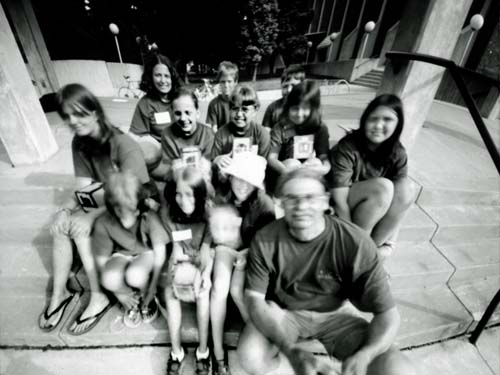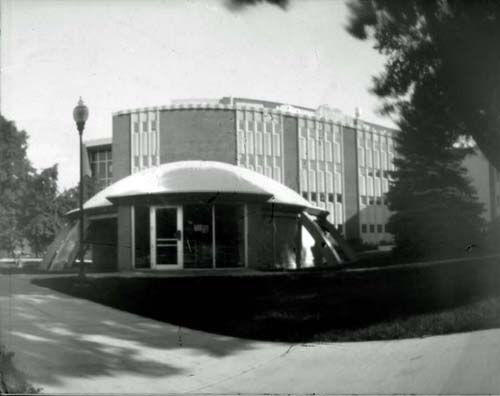In the early 90s, I horned in on a class for teachers to learn how to use the planetarium. That led to teaching a two week, 70 minutes a day astronomy class in the summer to 4th through 7th graders who had been certified by their teachers as gifted. Pertinent to this blog, when the organizers of the program surveyed the teachers for ideas to expand the offerings, I suggested Pinhole Photography and they went for it. It occured four times between 2001 and 2006. I can't believe I had the energy to do these things. I remember them as a tremendous amount of work. But it is extremely cool to watch children learn.
My favorite activity took place just once, in 2005. (OK, historians, f295 had started the year before.) There were ten children in the class and an education major assigned to help me.
We had already built cameras and had been taking photographs for a week.
I brought eleven cameras of different sizes, angles of view and curved and flat film planes. In the activity I had in mind each kid would take one camera and take a properly exposed picture of the planetarium from the same spot to see how the images changed.
I specifically chose the view to show the change of the rendition of space and the distortion of lines of Halsey Science Center behind the planetarium. This was at about 9:30 am with trees still casting shadows on the planetarium.
The web page for it is still accessible at the Wayback Machine.
Cameras with flat film planes
This was the camera we all had built and had been using. The one in the photo was built in a previous session by one of the older kids who took home the camera I had made instead of this one. He was a smart kid and got into it well enough, but he would have rather been playing football.
I learned how to make these cameras in a workshop with Ruth Thorne-Thomsen twenty years earlier.
I know I still have this camera somewhere. It was one of the three foamcore cameras I made for my own use. I made it so I could get close-up views of my south kitchen window without putting the tripod in the sink. This is a detail from a portrait of my cameras that was in The Pinhole of Nature. Incidentally, this picture of the camera was done with the five inch camera above with the kid-drilled pinhole. At ten inches it of course has half the angle of view and requires four times the exposure.
This was another of the cameras I regularly used myself. Twice the angle of the five inch and with the same pinhole, a quarter of the required exposure time. When I made it my intention was to have a faster cameras to try to catch plants standing still and not to necessarily have a wider angle.
I made the camera especially for this exercise with same design as the five inch camera above. I no longer have it. It was displayed on a table in my office for years. The little collection was under some plants and was always getting wet when I overwatered them. I probably threw it away when I retired. Looks like a light leak in the upper left corner.
This one is exactly twice the size of the previous camera so the images should look pretty much the same. I had made it a few years before to demonstrate some of these same objectives to the earlier classes. It's been the paper safe in my darkroom ever since.
Exactly twice the size as the 4x5 five inch camera above, so a similar angle of view. I had originally made it to impress the kids when we did a group portrait in the workshop in 2001. (They weren't impressed).There was an extremely serious light leak and the negative looked essentially black. I photographed the negative on a light table and stretched the contrast to the limit to get the image back to something we could compare with the others.
Curved back cameras
To illustrate the barrel distortion of lines along a curved image plane, I had two of these. One was with the can sitting upright. With everybody trying to take pictures from the same place, I'm surprised there wasn't more bumping of cameras.
This is another camera which was in that display under the plants in my office which I no longer have. I didn't make this one. Probably through an interaction on Pinhole Visions email list, Jim Kosinski sent me one of his patented cameras, which you can still get at http://www.paintcancamera.com/ Since it's a less extreme curve farther from the image plane, it should be less wide angle than the La Choy noodle cans.
Another camera that I don't have. This photo is of an 8x10 version. I made both the 4x5 and 8x10 versions specifically for this exercise. No one chose the 8x10. This configurations has an almost 180 degree angle of view. You can see other children setting up next to this one.
This type of camera has become ubiquitous for solargraphy since Tarja Trygg started mailing them around the world. Since it's almost the same proportions as the La Choy cans, the angle of view is almost identical. The pinhole on this one is a .15mm Gilder electron microscope aperture.




































Looking forward to the Lab Camera results.
ReplyDeleteGreat article, Nick. It's rewarding to work with kids.
ReplyDelete